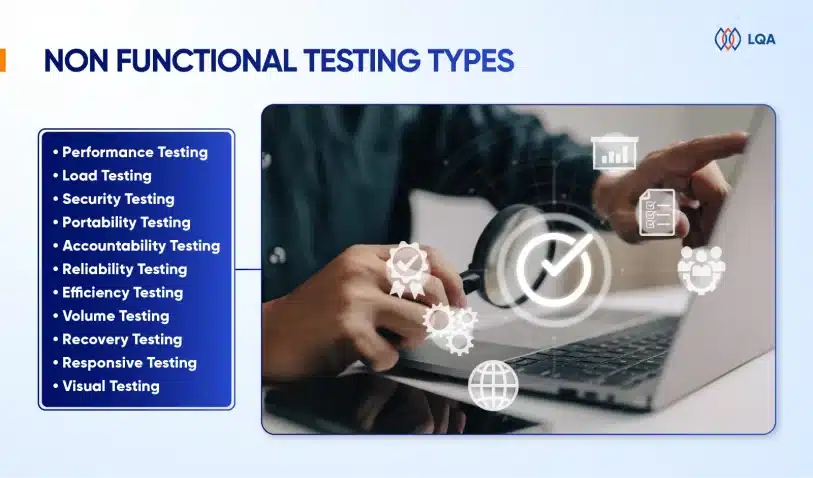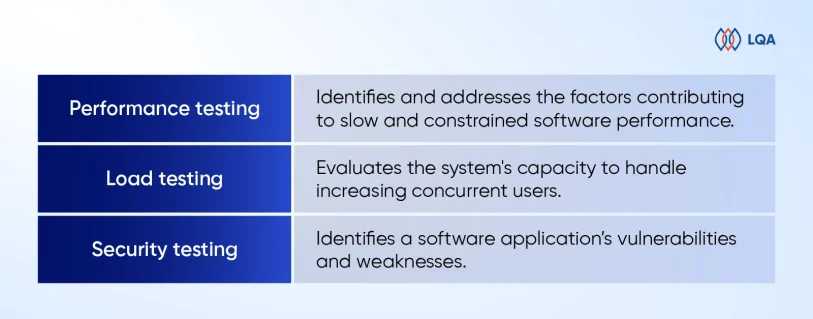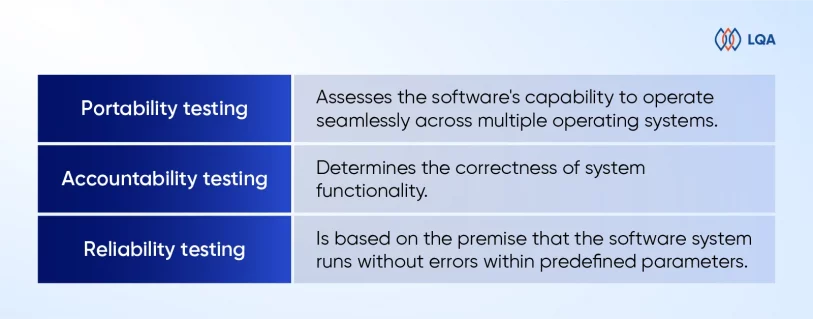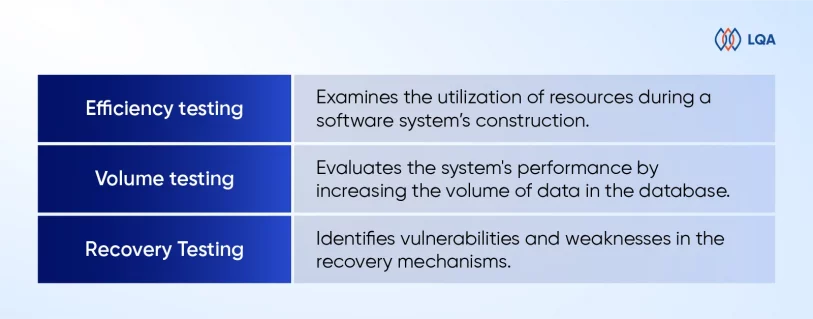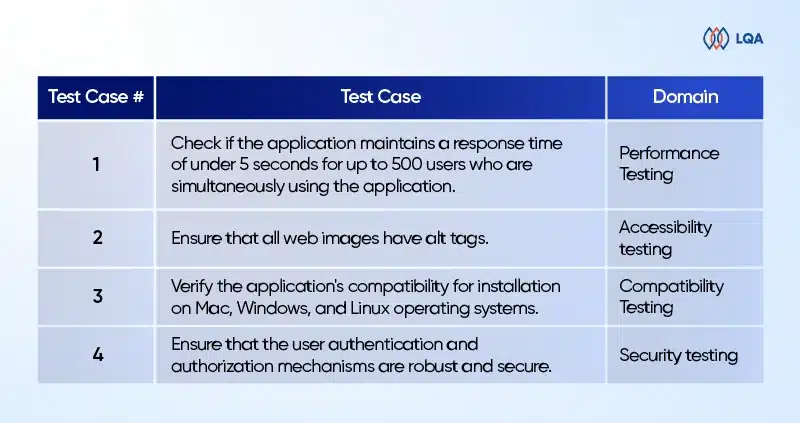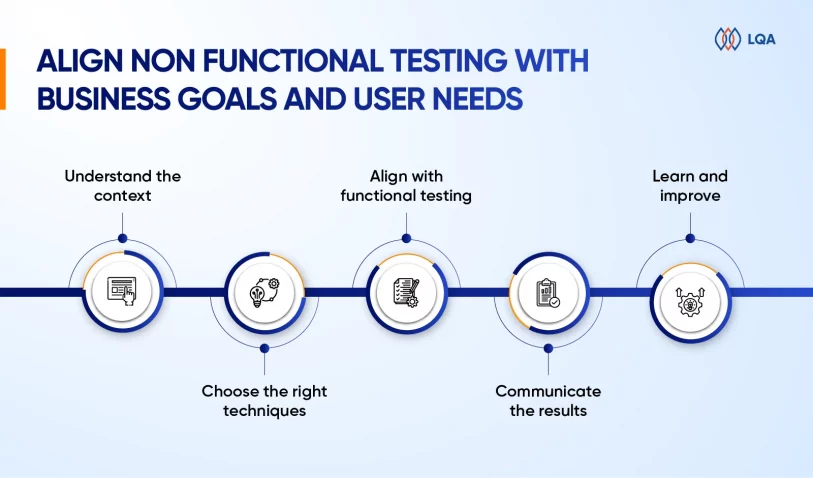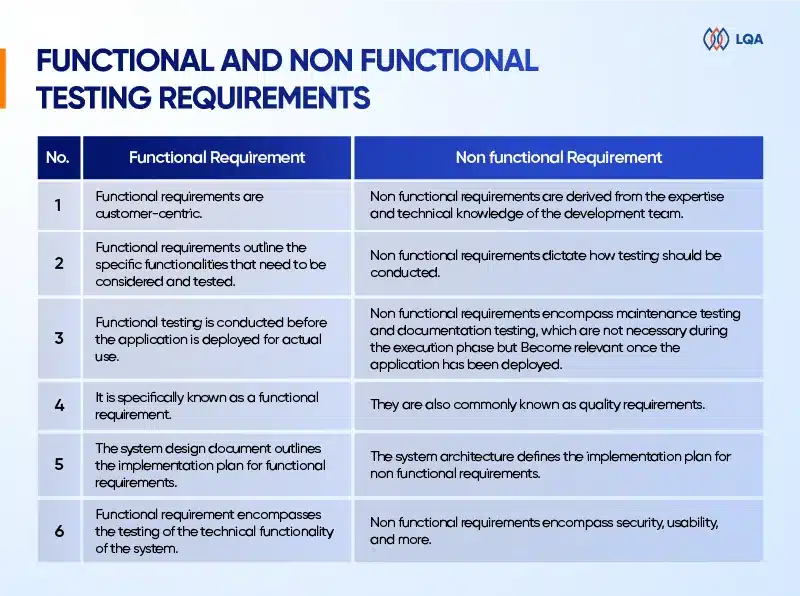
Non functional testing and functional testing are both vital to ensure that your product operates as intended. Non functional testing examines aspects that go beyond functionality. It guarantees a superior level of product quality, performance, and usability, which can improve user satisfaction.
Within this blog post, we will provide a comprehensive definition of non functional testing. Furthermore, we will explore a range of examples showcasing non functional tests, shedding light on the specific areas they assess.
Additionally, we will guide you on the most effective approach to aligning non functional testing with your business objectives and user requirements, enabling your business to deliver a remarkable product that fulfills both functional and non functional testing expectations.
What Is Non Functional Testing?
Non functional testing is a critical software testing methodology that assesses an application’s non functional components, encompassing usability, performance, scalability, reliability, security, compatibility, and more.
→ Take a look at: LQA’s software testing services
Non functional testing focuses on ensuring the overall product quality rather than merely examining its features. You have to understand the significant impact that non functional testing has on a product.
In the realm of software development, non functional testing has equal importance to functional testing. Without it, a system may exhibit flawless performance in a controlled environment and encounter significant failures when confronted with real-world conditions.
Why Use Non Functional Testing?
Functional and non functional testing are both crucial for any software. Functional testing ensures the correct functioning of internal features, while non functional testing evaluates how well the software performs in the external environment.
Non functional testing plays a vital role in examining various aspects such as performance, stability, responsiveness, portability, and more. It involves assessing the software’s installation, setup, and execution.
By gathering measurements and metrics, non functional testing facilitates internal research and development efforts. It provides valuable insights into the software’s behavior and the technologies employed. Moreover, it helps mitigate production risks and reduces associated software costs.
Non Functional Testing Characteristics
The essential traits of non functional testing include:
- Non functional testing necessitates quantifiable metrics. Therefore, using subjective terms such as “good,” “better,” or “best” is not appropriate for this type of testing.
- During the initial stages of the requirement process, it may be challenging to ascertain precise figures.
- Giving priority to the requirements holds immense significance in non functional testing.
Non Functional Testing Types
The following are the prevalent types of non functional testing:
1. Performance testing
Performance testing aims to identify and address the factors that contribute to slow and constrained software performance. The software must exhibit fast response times, ensuring an efficient user experience.
To conduct effective performance testing, businesses should establish a well-defined and specific set of requirements regarding the desired speed. Without clear specifications, it’s hard to determine whether the test results indicate success or failure.
For instance, if 1000 users access an application together, the load time should not exceed 5 seconds.
Tools used: LoadRunner, Apache JMeter, WebLOAD.
2. Load testing
We use load testing to evaluate the system’s capacity to handle increasing concurrent users. It specifically assesses the system’s loading capability and its ability to cope with higher user loads. By simulating real-world scenarios, load testing helps identify potential bottlenecks and performance issues under heavy usage.
To gauge a website’s speed and performance, you can run a quick website speed test, which provides insights into the website’s speed scores. This helps measure the website’s responsiveness and overall user experience.
Tools used: Neoload, Load Multiplier.
3. Security testing
Security testing is employed to identify a software application’s vulnerabilities and weaknesses. This type of testing involves examining the system’s design and adopting the mindset of a potential attacker.
By scrutinizing the application’s code, and potential attack vectors, security testers can pinpoint areas where an attack is most likely to occur. This knowledge is then used to create targeted and effective test cases that assess the application’s resilience against potential security breaches.
Tools Used: ImmuniWeb, Vega, Wapiti
4. Portability testing
Portability testing focuses on assessing the software’s capability to operate seamlessly across multiple operating systems without encountering any bugs or compatibility issues.
Additionally, this testing also examines the software’s functionality when deployed on the same operating system but with different hardware configurations. By conducting portability testing, one can ensure that the software performs consistently and reliably across various environments, enhancing its usability and flexibility.
Tools Used: SQLMap.
5. Accountability testing
Accountability testing plays a crucial role in determining the correctness of system functionality. The primary objective is to ensure that each function in the system consistently produces the expected outcome for which it was designed.
If the system generates the desired results, it passes the accountability test; however, if it fails to do so, it indicates a potential flaw or malfunction in the system’s functionality.
By conducting thorough accountability testing, one can effectively assess and validate the system’s performance and its ability to meet the intended objectives.
Tools Used: Mentimeter.
6. Reliability testing
Reliability testing is based on the premise that the software system runs without errors within predefined parameters. It involves running the system for a specified duration and several processes to assess its reliability.
The reliability test is considered unsuccessful if the system fails under predetermined circumstances.
For instance, in the case of a website, all web pages and links should be dependable and function reliably. If the system exhibits issues or malfunctions, such as broken links or errors, during the reliability test, it indicates a failure to meet the expected reliability standards.
By conducting reliability testing, one can evaluate the system’s ability to consistently operate as intended and identify any potential weaknesses or areas for improvement in terms of reliability and error-free performance.
Tools Used: Test-retest, Inter-rater.
7. Efficiency testing
Efficiency testing examines the utilization of resources during a software system’s construction, assessing both the actual resources employed and the ones required. This type of testing aims to determine the efficiency and optimization of resource usage throughout the software development process.
By analyzing resource consumption, such as CPU usage, memory utilization, or network bandwidth, efficiency testing provides insights into the software system’s resource requirements and helps identify potential areas for improvement in resource allocation and utilization.
Tools Used: WebLOAD, LoadNinja.
8. Volume testing
Volume testing, also referred to as flood testing, is a type of software testing that entails subjecting the software to a substantial amount of data. Its purpose is to evaluate the system’s performance by increasing the volume of data in the database.
By simulating scenarios with a large and often excessive amount of data, volume testing helps assess the system’s ability to handle and process such data loads without compromising its performance or stability.
This type of testing ensures that the software can effectively manage and scale with growing data volumes, thus preventing any potential bottlenecks or performance issues.
Tools Used: HammerDB, JdbcSlim.
9. Recovery Testing
Recovery testing assesses an application’s resilience in recovering from crashes, hardware failures, and similar issues.
By intentionally breaking the software through simulated scenarios, recovery testing aids in identifying vulnerabilities and weaknesses in the recovery mechanisms. This type of testing helps make sure that the application can gracefully handle unexpected failures, quickly restore functionality, and minimize any potential data loss or system downtime.
Tools Used: Box Backup, Bacula.
10. Responsive testing
Responsive testing enables you to evaluate your design across a range of screen widths, providing a more authentic assessment of its adaptability rather than relying solely on predetermined screen sizes.
By utilizing specialized tools, you can test your website’s responsiveness by adjusting the screen width dynamically after entering the website’s URL.
This allows you to observe how your user interface adapts and adjusts in real-time to accommodate different screen sizes.
The primary objective of evaluating responsive websites is to ensure a seamless and friendly user experience across various digital devices. By conducting responsive testing, we can ensure that websites and applications deliver a smooth and consistent experience to users, regardless of the device they are using.
Tools Used: Responsinator, Screenfly, Google DevTools Device Mode.
11. Visual testing
One way to address issues is using visual testing (or visual UI testing). This type of testing focuses on validating whether the software user interface (UI) is displayed correctly to every user.
Visual tests meticulously examine each element on a web page to ensure they have the proper shape, size, and placement as intended. By comparing the application’s visible output to the expected design outcomes, visual testing helps identify “visual bugs” that may exist, separate from functional bugs that affect the software’s overall functionality.
In essence, visual testing plays a crucial role in detecting any discrepancies or issues related to a page or screen’s appearance and presentation.
Tools Used: Percy, PhantomCSS, FBSnapshotTestCase, Gemini, Needle (Uses Python).
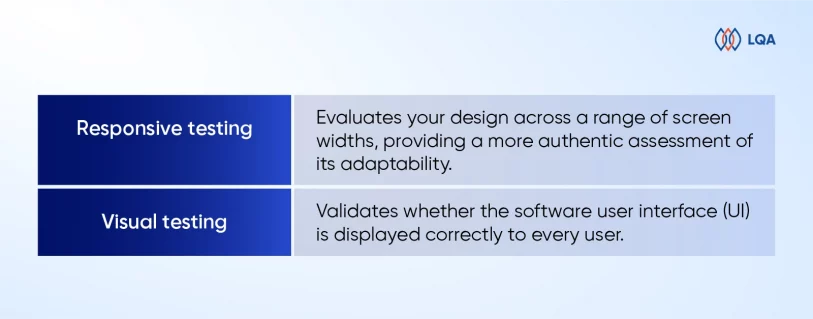
→ Read more:
- Best Software Testing Methods to Ensure Top-quality Applications
- 5 Steps To Hire A Test Automation Engineer
- How to Choose an Automation Testing Services Provider
Non Functional Testing Parameters
Let’s delve into these parameters and examine them in detail:

- Security: The security parameter establishes the level of protection a system has against both intended and unintended attacks originating from internal or external sources. Security testing is conducted to assess and verify this protection.
- Reliability: The reliability parameter examines a system’s capability to perform its intended functions consistently, without any failures over a specific duration. Using reliability testing to evaluate and validate this ability.
- Survivability: The survivability parameter determines a product’s capacity to maintain its operation and recover from failures or disruptions. We use recovery testing to assess and validate this ability.
- Availability: The availability parameter determines the level of reliability and consistency a user can expect from a system and its functionalities during operation. We use stability testing to measure and evaluate this parameter.
- Usability: The usability parameter gauges the user’s ease of interaction with a product, including learning, operating, and input/output preparation. Usability testing is employed to evaluate this aspect and ensure optimal user experience.
- Scalability: Scalability assesses a system’s capability to adjust its performance in response to varying workloads without compromising its effectiveness. Scalability testing is used to evaluate this ability and ensure optimal performance.
- Interoperability: The interoperability parameter determines a system’s capacity to interface with other software systems smoothly. Interoperability testing is conducted to verify this ability and ensure smooth integration.
- Efficiency: Efficiency measures the software system’s ability to handle volume, capacity, and response time effectively.
- Flexibility: Flexibility refers to the application’s continuous operation across a wide range of hardware and software configurations. For instance, most applications have specific minimum RAM and CPU requirements to ensure proper functionality.
- Portability: Portability refers to the ease with which an application can transit from one hardware or software environment to another.
- Reusability: Reusability denotes a component or module in a software system that can be utilized in multiple applications.
Best Practices Of Non Functional Testing
To achieve effective non functional testing, you should take certain best practices into account.
- Early engagement: Engage in non functional test activities starting from the early phases of the software development life cycle (SDLC). Collaborate closely with stakeholders, architects, and developers to comprehend non functional requirements and incorporate them into the system design.
- Well-defined goals: Establish precise and measurable objectives for non functional testing. Set clear targets for performance, security, usability, and other non functional aspects to guide the testing process and provide a basis for evaluation.
- Realistic test environment: Set up a test environment that resembles the production environment. Use representative hardware, software, network configurations, and data volumes to ensure accurate analysis of performance and behavior.
- Test automation: Employ test automation tools and frameworks to streamline and expedite non functional testing. Automation facilitates the simulation of user loads, generation of consistent test data, and execution of repetitive tasks, resulting in more efficient and dependable testing.
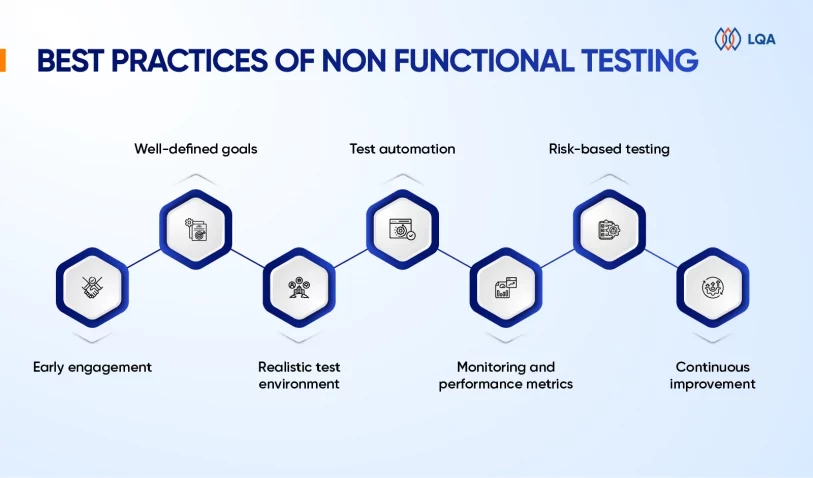
→ Don’t miss: 10 BEST Automation Testing Companies Worldwide in 2023
- Monitoring and performance metrics: Implement robust monitoring mechanisms throughout testing to capture performance metrics such as response times, resource utilization, throughput, and error rates. These metrics provide valuable insights into system behavior, aid in identifying bottlenecks, and facilitate performance analysis.
- Risk-based testing: Prioritize non functional test cases based on risk analysis and their impact on business operations. Give attention to critical functionalities, high-risk areas, and cases that are likely to lead to performance degradation, security vulnerabilities, or usability issues.
- Continuous improvement: Foster a culture of ongoing improvement by leveraging insights from testing experiences and incorporating feedback into subsequent iterations. Capture lessons learned, update documentation, and refine testing strategies based on the knowledge gained during non functional testing.
These practices represent only a fraction of the existing methods for efficient non functional testing. By adhering to them, organizations can conduct effective non functional testing to ensure optimal performance, security, usability, and other non functional attributes of their software systems.
Examples Of Non Functional Testing
To gain a better understanding of this concept, let’s explore some examples of non functional testing across different types. The table below illustrates a range of non functional test cases specifically for web applications.
How To Align Non Functional Testing With Business Goals And User Needs?
Here are some valuable tips to seamlessly align non functional testing with your business objectives and user requirements.
Understand the context
Before commencing non functional testing, you should comprehend the project context, your intended audience, and your business goals.
What are your users’ and clients’ expectations and demands? What are your domain’s and environment’s risks and challenges? Which standards and regulations apply to your software?
Addressing these queries will assist in defining the scope, criteria, and priorities for your non functional testing.
Choose the right techniques
Non functional testing is not a one-size-fits-all approach. Depending on the context, different techniques and tools may be required to measure and evaluate the non functional aspects of your software.
For instance, we use load testing, stress testing, and endurance testing to assess system performance under varying levels of demand. Usability testing, accessibility testing, and user experience testing can be utilized to evaluate user satisfaction and convenience.
Security testing, penetration testing, and vulnerability testing can help identify and mitigate potential threats and breaches. Maintainability testing, portability testing, and compatibility testing ensure software adaptability and interoperability.
Align with functional testing
Non functional testing should not be treated as a standalone or separate activity from functional testing. Instead, it should be integrated and harmonized with functional testing throughout the software development life cycle.
This approach ensures the relevance, consistency, and comprehensiveness of nonfunctional testing while avoiding duplication, confusion, and conflicts with functional testing.
For instance, leveraging test automation allows for efficient and effective execution of both functional and non functional testing.
Additionally, incorporating non functional requirements and specifications into test cases and code through test-driven development, or behavior-driven development further enhances the integration of non functional aspects.
Communicate the results
Non functional testing goes beyond simply identifying and addressing defects. It also offers valuable insights and feedback to stakeholders and users. Therefore, you should communicate the results of non functional testing in a clear, concise, and persuasive manner.
You can apply various methods and formats to present and report non functional testing results, including graphs, charts, dashboards, metrics, or narratives. Additionally, different channels and platforms can be used to share and discuss these results, such as emails, meetings, demos, or blogs.
The key is to emphasize the benefits and impacts of non functional testing on business goals and user requirements.
Learn and improve
Non functional testing is not a one-off or stagnant endeavor. It’s an ongoing and dynamic process that necessitates continual learning and improvement. Regular and frequent monitoring and measurement of software performance and quality are essential.
→ Read more:
- How to Create A Test Plan? Components, Steps and Template
- Benefits of Test Automation: Efficiency, Accuracy, Speed, and ROI
- A Comparison of Manual Testing vs. Automation Testing
Furthermore, you should review and update non functional testing strategies and techniques in response to the evolving needs and expectations of stakeholders and users. You can apply range of sources and methods, such as surveys, interviews, reviews, or analytics to collect and analyze feedback and data.
Additionally, leveraging various tools and frameworks, such as DevOps, Agile, or Lean, can provide support and enhance non functional testing efforts.
Differences Between Functional And Non Functional Testing Requirements
Let take a quick look at some differences between nonfunctional testing and functional testing:
FAQ
What is functional vs non functional testing?
Functional testing ensures that the application works as intended. In contrast, non functional testing evaluates the application’s efficiency, performance, security, scalability, reliability, and portability.
What are non functional testing examples?
Non functional testing focuses on evaluating the non functional aspects of the product. To gain a clearer understanding, consider the following examples:
- Validate that the application’s dashboard loads within 5 seconds upon login.
- Ensure that email notifications are dispatched within 3 minutes.
- Verify that the application supports concurrent login by 500 users simultaneously.
What are the challenges of non functional testing?
Below are several risks related to non functional testing:
- Risk #1: Performance bottlenecks.
- Risk #2: Security vulnerabilities.
- Risk #3: Subpar user experience.
- Risk #4: Compatibility issues.
- Risk #5: Scalability challenges.
What will happen if non functional requirements are ignored?
Neglecting non functional requirements (NFRs) can significantly affect the adoption of the system, leading to various consequences.
These include the system’s inability to scale up to meet customer demands, sluggish performance resulting in unresponsiveness, security breaches compromising confidential data, and system unavailability during critical periods. Those directly impact business operations.
What is the main goal of non functional testing?
The objective of non functional testing is to enhance the usability, effectiveness, maintainability, and portability of the product. This testing process helps mitigate the manufacturing risk associated with the non functional aspects of the product.
Final Thoughts On Non Functional Testing
Non functional testing plays a crucial role in guaranteeing the overall quality and success of software systems. It extends beyond functional requirements and concentrates on pivotal aspects such as performance, security, usability, scalability, and reliability.
By conducting comprehensive non functional testing, organizations can effectively mitigate risks, elevate user satisfaction, adhere to industry standards, and optimize costs.
At LQA, we have the excellent expertise, specialized skills, and knowledge to conduct comprehensive assessments and evaluations of non-functional attributes.
Our team is highly proficient in utilizing specialized tools and techniques, enabling them to proactively identify and address potential issues.
With our proficiency in performance testing, security testing, usability testing, and compliance testing, we are adept at uncovering hidden problems, optimizing system performance, enhancing security measures, and ensuring a seamless user experience.
Our ultimate goal is to provide clients with high-quality software systems that meet performance expectations, prioritize user satisfaction, safeguard against security threats, and comply with industry standards.
If you are eager to improve the quality and reliability of your software systems, we encourage you to reach out to LQA. Contact us today to discuss your testing requirements and elevate your software to new heights.
- Website:https://www.lotus-qa.com/
- Tel: (+84) 24-6660-7474
- Mail: [email protected]
- Fanpage: https://www.linkedin.com/company/lqa/

